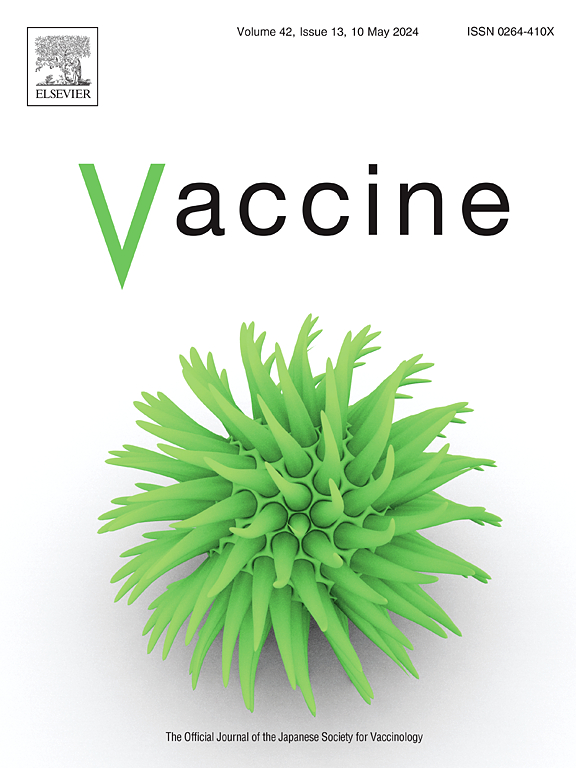PCV13高、低覆盖率地区肺炎链球菌鼻咽载体抗微生物药物非敏感性的不同模式
IF 4.5
3区 医学
Q2 IMMUNOLOGY
引用次数: 0
摘要
肺炎球菌结合疫苗(PCVs)对中国儿童肺炎链球菌(Spn)抗菌素耐药性(AMR)的影响尚不充分。关于疫苗接种覆盖率与抗菌素耐药性模式的区域差异之间的相互作用的证据也有限。本研究旨在评估13价肺炎球菌结合疫苗(PCV13)对中国5岁以下健康儿童鼻咽部携带Spn和对常用抗生素不敏感的影响。方法2022年在海南省4个地区(海口、万宁、白沙、琼中)从2333名健康儿童中分离出737株肺炎球菌。进行血清分型和药敏试验。根据个人PCV13疫苗接种史和当地疫苗接种率将参与者分为4组:高覆盖率地区接种疫苗组和未接种疫苗组(VH组和amp组;NVH),以及低覆盖率地区接种疫苗和未接种疫苗的群体(VL和amp;NVL)。采用描述性统计和逻辑回归分析来评估疫苗的影响。结果与未接种疫苗的儿童相比,接种了spcv13的儿童的疫苗型血清型(VTs)携带率显著降低:6B (7.0% vs. 2.7%, P <;0.01), 6A (4.2% vs. 1.2%, P <;0.05)和23F (2.2% vs. 0.3%, P <;0.05)。对红霉素、阿奇霉素、克林霉素、四环素、青霉素和头孢呋辛的不敏感率分别为92.3%、87.5%、81.2%、91.2%、38.9%和64.7%,导致82.9%的分离株出现多药耐药(MDR),尤其是对静脉曲霉(VTs)的不敏感率为92.4%。来自PCV13高覆盖率地区的分离株对青霉素、头孢呋辛、红霉素、阿奇霉素、克林霉素和sst的耐药性较低,耐多药率低于来自PCV13低覆盖率地区的分离株。结论Spn鼻咽携带对临床常用抗生素耐药程度较高。PCV13疫苗接种可显著降低VTs携带和抗微生物不敏感性。这些结果表明,pcv的广泛使用可能会实质性地影响NP携带和抗菌非敏感性。本文章由计算机程序翻译,如有差异,请以英文原文为准。
Different patterns of antimicrobial non-susceptibility of the nasopharyngeal carriage of Streptococcus pneumoniae in areas with high and low levels of PCV13 coverage
Introduction
The impact of pneumococcal conjugate vaccines (PCVs) on antimicrobial resistance (AMR) in Streptococcus pneumoniae (Spn) among Chinese children remains inadequately characterized. Evidence is also limited on the interaction between vaccination coverage and regional disparities in AMR patterns. This study aims to assess the impact of the 13-valent pneumococcal conjugate vaccine (PCV13) on nasopharyngeal carriage of Spn and antimicrobial nonsusceptibility to commonly used antibiotics among healthy children under five years of age in China.
Methods
In 2022, 737 pneumococci were isolated from 2333 healthy children recruited in 4 areas (Haikou, Wanning, Baisha, and Qiongzhong) in Hainan Province, China. Serotyping and antimicrobial susceptibility tests were performed. Participants were divided into 4 groups based on individual PCV13 vaccination history and the local vaccination coverage rates: vaccinated and unvaccinated groups in the high-coverage area (group VH & NVH), and vaccinated and unvaccinated groups in the low-coverage areas (group VL & NVL). Descriptive statistics and logistic regression analysis were used to assess the vaccine impacts.
Results
PCV13-vaccinated children exhibited significantly lower carriage rates of vaccine-type serotypes (VTs) compared to unvaccinated children: 6B (7.0 % vs. 2.7 %, P < 0.01), 6A (4.2 % vs. 1.2 %, P < 0.05), and 23F (2.2 % vs. 0.3 %, P < 0.05). The non-susceptibility rates to erythromycin, azithromycin, clindamycin, tetracycline, penicillin, and cefuroxime were 92.3 %, 87.5 %, 81.2 %, 91.2 %, 38.9 % and 64.7 %, respectively, resulting in 82.9 % of isolates being multidrug-resistant (MDR), especially to VTs (92.4 %). Isolates from the high PCV13 coverage area were less resistant to penicillin, cefuroxime, erythromycin, azithromycin, clindamycin and SXT, and were less MDR than isolates from the low PCV13 coverage areas.
Conclusions
Nasopharyngeal carriage of Spn was highly resistant to common clinical antibiotics. PCV13 vaccination significantly decreased VTs carriage and antimicrobial nonsusceptibility. These results suggest that the widespread use of PCVs is likely to substantially affect NP carriage and antimicrobial nonsusceptibility.
求助全文
通过发布文献求助,成功后即可免费获取论文全文。
去求助
来源期刊

Vaccine
医学-免疫学
CiteScore
8.70
自引率
5.50%
发文量
992
审稿时长
131 days
期刊介绍:
Vaccine is unique in publishing the highest quality science across all disciplines relevant to the field of vaccinology - all original article submissions across basic and clinical research, vaccine manufacturing, history, public policy, behavioral science and ethics, social sciences, safety, and many other related areas are welcomed. The submission categories as given in the Guide for Authors indicate where we receive the most papers. Papers outside these major areas are also welcome and authors are encouraged to contact us with specific questions.
 求助内容:
求助内容: 应助结果提醒方式:
应助结果提醒方式:


